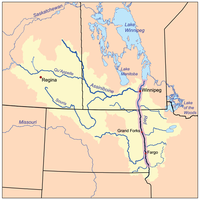| Part of a series on the |
| Red River of the North |
|---|
 |
| Major Floods |
| Geology |
| Infrastructure |
| Related Topics |

The Red River Floodway (French: Canal de dérivation de la rivière Rouge) is an artificial flood control waterway in Western Canada. It is a 47 km (29 mi) long channel which, during flood periods, takes part of the Red River's flow around the city of Winnipeg, Manitoba to the east and discharges it back into the Red River below the dam at Lockport. It can carry floodwater at a rate of up to 140,000 cubic feet per second (4,000 m3/s), expanded in the 2000s from its original channel capacity of 90,000 cubic feet per second (2,500 m3/s).[1][2]
The Floodway was pejoratively nicknamed Duff's Ditch by opponents of its construction, after Premier Duff Roblin, whose Progressive Conservative government initiated the project, partly in response to the disastrous 1950 Red River flood. It was completed in time and under budget. Subsequent events have vindicated the plan, leading to the nickname becoming an affectionate one.[3] Since its completion in 1968, the Floodway is estimated to have prevented over $40 billion in cumulative flood damage.[4] It was designated a National Historic Site of Canada in 2000, as the floodway is an outstanding engineering achievement both in terms of function and impact.[5]
From south to north, the Floodway passes through the extreme southeastern part of Winnipeg and the rural municipalities of Ritchot, Springfield, East St. Paul, and St. Clements.
- ^ "Red River Floodway". Manitoba Government - Flood Information. Government of Manitoba. Archived from the original on 16 July 2017. Retrieved 27 July 2017.
The expansion of the current floodway system (including the West Dike and channel outlet) began after the 1997 flood, to protect the City of Winnipeg from a one-in-700-year flood. It increased the floodway's capacity - from 90,000 cfs (cubic feet per second) to 140,000 cfs.
- ^ Cash, Martin (26 April 2014). "Red River Floodway expansion debate flows on". Winnipeg Free Press. Archived from the original on 27 April 2014. Retrieved 26 April 2014.
Open shop (non-union) construction companies bid on and effectively completed work that increased the capacity of the Floodway from 1,700 cubic metres of water per second to 4,000 cubic metres.
- ^ Cite error: The named reference
Manitoba Floodway Authoritywas invoked but never defined (see the help page). - ^ "Red River Floodway". Manitoba Government - Flood Information. Government of Manitoba. Archived from the original on 16 July 2017. Retrieved 27 July 2017.
Since 1968, it has prevented more than $40 billion (in 2011 dollars) in flood damage in Winnipeg.
- ^ Red River Floodway. Canadian Register of Historic Places. Retrieved 10 June 2012.